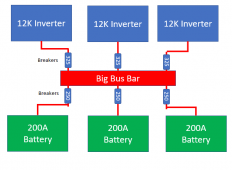OzSolar
Whatever you did, that's what you planned.
That's a great point! One that never seems to get mentioned which has stood out at as odd to me. It's been my plan the whole time.Also just a note on this going back over these posts:
If you put these in parallel using their parallel cables, make sure that you don't pull 1C from the batteries, becaues that would melt the 50mm2 cable that comes with. I would say max 200A from the whole pack(they are rated at 250A, but recommended max is 200A), if you need to go higher then you need to do that same as I am doing.




